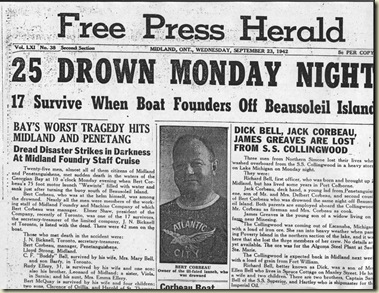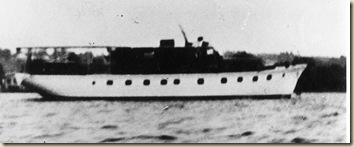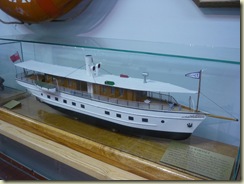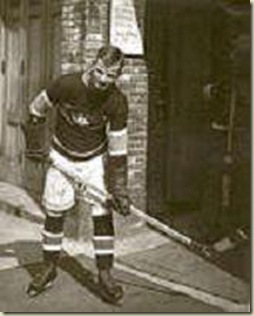 Canadiens defenceman Bert Corbeau was amongst 25 men drowned on September 21, 1942. Newspaper copy provided courtesy Huronia Museum
Canadiens defenceman Bert Corbeau was amongst 25 men drowned on September 21, 1942. Newspaper copy provided courtesy Huronia Museum
He was considered one of the toughest and best defensemen of his era. But on September 21, 1942, former Montreal Canadiens and Toronto Maple Leafs rearguard Bert Corbeau met his match in the waters of Georgian Bay.
The native of Penetanguishene, long retired as a player and no longer coaching, had returned home to help his community’s effort during World War Two in 1942.
Working as a plant superintendent at the Midland Foundry and Machine Company, Corbeau and his staff worked long days to aid Canada’s war effort.
After a successful work order was completed, Corbeau issued a memo for his men;
You are invited to attend a stag party.
Aboard my boat on Monday Sept. 21 at 4 P.M.
For a buffet lunch and refreshments.
Come one and all.
Prizes Will be awarded to the best fishermen.
Plant Superintendent
B. Corbeau
Forty-two men set out on Corbeau’s boat the Wawinet, on that clear Monday afternoon at 4:00 p.m., but only 17 would return.
After making the trip to from Penetanguishene to Honey Harbour, with a brief stop at the Delawana Inn, Corbeau began to make trip back home.
 The Wawinet – The portholes had allegedly been cut from round to rectangular by Corbeau. Earlier photos seem to refute this. Photo: The Huronia Museum
The Wawinet – The portholes had allegedly been cut from round to rectangular by Corbeau. Earlier photos seem to refute this. Photo: The Huronia Museum
At about 9:50pm, the Wawinet struck a sand bar on the south end of Beausoleil Island and listed to the starboard side and, with the portholes open, began to take on water.
One report said you could see a 25 foot rift in the sand bar where the boat had struck.
Despite Corbeau’s warnings, the men rushed to the port side out of panic and the boat buckled to that side, taking on more water. The boat quickly began to sink rapidly.
Witness accounts, in an article by Gordon Sinclair of The Toronto Star, state that Corbeau may have been thinking to go down with the boat, but not before trying to save his guests.
“I was up in the wheelhouse with Bert when we were on the way home,” said survivor Chas Rankin.
“There were two others there and Bert was talking with one of these when he swung hard left to come around. She heeled over pretty heavy and, with the large square windows open, they filled with a great gush of water and she went down within two minutes.”
“When Bert saw what happened, he didn’t want to be saved,” Rankin continued.
“We were both beside Bert and there was a bright moon. As the boys were struggling in the water, Bert peeled off his clothes and said ‘You boys swim for it..Good luck.’”
“Bert and I went out out of the wheelhouse sort of sideways and I pulled off my windbreaker sort of sideways and trod water where he was. I saw Bert take hold of one chap and pulled him up to the boat as she hesitated before making the plunge.”
“You’re dead right,” echoed fellow survivor Stewart Cheetham on Rankin’s account.
“I was below in the galley when she swung around sharp and the water started pouring in through the side windows. Charles Rankin started swimming straight off and Bert Corbeau climbed climbed up to where I was . He looked the whole picture over in the moonlight then he just slid in. Bert Corbeau was a strong swimmer and a very good guy.”
In all chances, Corbeau tried to save as many as he could before succumbing to the frigid waters of Georgian bay.
With only two lifeboats in tow, one capsized, and no lifejackets, the survivors clung to what they could, if anything, and swam to Beausoleil Island. Soon they realized that they were in shallow water and walked to shore. The men, cold and wet huddled in a small cabin on the Island’s YMCA camp.
For others on the far side of the boat, the only land in sight was the further Present Island. Few successfully made that long swim.
Rescuers would not arrive until the next morning.The local police in Midland were not made of the tragedy until 5:00 a.m. Tuesday morning, once reports from families of the missing men and the discovery by morning boaters trickled in.
 A model of the Wawinet on display at the Huronia Museum
A model of the Wawinet on display at the Huronia Museum
How the Wawinet came to strike sandbar has been questioned for decades.
There was speculation that alcohol was a factor. Many survivors said there had been little drinking on board, and Corbeau’s blood alcohol level was found to be within limit. Witnesses did say a one or two rounds had been bought at the Delawana before it’s departure.
Another theory is that there was some horseplay, or a scuffle on the bridge. Witnesses stated that up to five men were up top and some took turns at the wheel. Maybe things got a bit out of hand and Corbeau found the boat off course and was unable to regain control in time.
Another report, but less unlikely, claims Corbeau liked to rock the boat to amuse his passengers, perhaps rocking it one too many times.
Chas Rankin’s account verifies the sharp turn but does not mention an incident with the men in the wheelhouse or Corbeau rocking the boat.
The structure of the 75-foot boat also came into question, as Corbeau had made several modifications to the 38-year-old Wawinet that may not have made the boat top heavy and unbalanced.
That with the fact that Corbeau may not have been licensed to operate a boat with that many passengers, may have led more to the tragedy.
Elmer Shaw, the owner of the Midland Foundry, confirmed that another employee was at the wheel earlier in the evening, but that Corbeau was the the helm on the return trip. He also gave an account that little alcohol was involved on the trip and noted the boat’s unbalanced structure.
 Bert Corbeau was a member of the Montreal Canadiens first Stanley Cup winning team and played for the Hamilton Tigers and Toronto St. Pats/Maple Leafs.
Bert Corbeau was a member of the Montreal Canadiens first Stanley Cup winning team and played for the Hamilton Tigers and Toronto St. Pats/Maple Leafs.
Regardless of how it happened, for the people of Penetanguishene and Midland, the tragedy could not have come at a worse time.
Residents of the area were already reading reports in the weekly newspapers of the war unfolding. Stories of family lost, killed or taken prisoner in the European theatre of World War Two already brought enough heartbreak to the area.
As Raymond Desrochers put it in his account ten years ago, "It was a time when the loss of the breadwinner held terrible consequences for the remaining family. There were few social supports and few people had life insurance.”
With the war still raging on however, foundry owner Shaw had no choice but to re-open his shop three days later.
“We have only sixteen men left now out of a staff of around forty but shall build up our organization rapidly from local people,” he said. “Only three members of the staff did not go on the trip.”
As a new resident to the Midland-Penetag area, I’ve spent the last several months researching and learning more about this tragedy and the life of Mr. Corbeau.
Hopefully I can learn more. I still have to make a trip to the Penetanguishene Sports Hall of Fame, where Bert Corbeau is an inductee, and am awaiting some further information from other sources. If anyone else has other information, please email me.
I’d like to dedicate this article to the victims, survivors and their families from this tragic event.
The victims from September 21, 1942:
From Penetanguishene: Aimé Lalumière, Bert Corbeau, Jack Magnus, Arthur Legault, George Todd, Mitch Maracle, Norman Roberts, Jack McLaughlin, Bert Mason, Arthur Bingham.
From Midland: F. 'Buddy' Bell, Bert McQuay, Richard Cornelius, William Clark, Lloyd Strong, Rudy Ellery, Elgin Scott, Harry Gillespie, Ted Contois, Alvin Bourdon
From Port McNicholl: Moïse St-Denis, Joe Staruck
From Wyebridge: Gordon Eakley
From Toronto: Albert A. Dix, J.N. Bicknell
The survivors:
From Midland: Charles Rankin, Joseph Parker, Al Miller, Mort Garrett, Orville McClung, Harry Lavigne, Stanley Leclair, Albert Perrault, Basil Somers, Henry Deschamps, Kenneth Lower, Robert Shaubel.
From Wyevale: Ernie Robbins, Thomas Davidson
From Penetanguishene: Laurie Goutte.
From Toronto: Elmer Shaw
From Brantford: Stewart Cheetam
Special note of thanks:
Putting this story together would not have been possible without the help of Genevieve Carter, at the Huronia Museum, for getting me in the right direction, as well as Jenny Suttaby, author R.B. Fleming, and Bruce Pratt for getting me some other photos and information on the Wawinet.






No comments:
Post a Comment